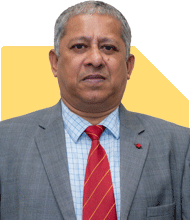Ramalingam Kalirajan |7279 Answers |Ask -Follow
Mutual Funds, Financial Planning Expert - Answered on Dec 18, 2024
He has an MBA in finance from the University of Madras and is a certified financial planner.
He is the director and chief financial planner at Holistic Investment, a Chennai-based firm that offers financial planning and wealth management advice.... more

Hi Sir, I want 1crore value in my mutual fund next 4year. Current value of my portfolio is Rs.14 lac. Total Monthly sip is Rs.12500. following are the fund with monthly sip amount. Sir, seek your advice is there need any change in fund or increase sip value. 1) MIRAE ASSET LARGE AND MID CAP FUND RS.2500/- 2) MIRAE ASSET LARGE CAP FUND RS.2500/- 3) PARAG PARIKH FLEXI CAP FUND RS.3000/- 4) AXIS ELSSTAX SAVER FUND RS.1500/ 5) AXIS MULTI CAP FUND RS.1500/- 6) HDFC INDEX FUND RS.1500/-
Assessing Your Target
Rs. 1 crore in 4 years implies a substantial annual growth requirement.
Current portfolio value: Rs. 14 lakhs.
Monthly SIP: Rs. 12,500.
Achieving the target requires aggressive contributions and equity market support.
Evaluating Your Fund Choices
Your portfolio includes a mix of funds from various categories. Here's an evaluation:
Large and Mid-Cap Fund: Balanced exposure to large and mid-cap stocks.
Large-Cap Fund: Focuses on stable, blue-chip companies but with moderate growth potential.
Flexi-Cap Fund: Offers diversified exposure across market caps.
Tax Saver Fund (ELSS): Suitable for tax savings but has a 3-year lock-in period.
Multi-Cap Fund: Broad diversification but overlaps with the flexi-cap category.
Index Fund: Tracks an index but lacks active management benefits.
Identifying Overlaps in Your Portfolio
Both flexi-cap and multi-cap funds provide broad diversification.
Large-cap and index funds overlap in exposure to blue-chip companies.
Consider consolidating funds to streamline your portfolio.
Disadvantages of Index Funds in Your Case
Index funds are passive and follow a predefined index.
They cannot outperform the market or manage downside risks effectively.
Actively managed funds can generate better returns with experienced fund managers.
Steps to Optimise Your Portfolio
Increase SIP Contributions
Rs. 12,500 monthly SIP may not meet your target.
Incrementally increase SIPs to Rs. 25,000 or more if possible.
Focus on High-Growth Potential Funds
Allocate more to funds with mid and small-cap exposure for higher returns.
Avoid over-diversification to enhance impact.
Review ELSS Allocation
Tax-saving funds are great for deductions but restrict liquidity for three years.
Keep ELSS allocation only if tax-saving benefits are required.
Exit or Reduce Index Fund Allocation
Replace the index fund with an actively managed fund for better performance.
Seek funds with strong past performance and consistent management.
Streamline Portfolio
Maintain a maximum of 4–5 funds to avoid overlap.
Choose funds with distinct strategies and complementary roles.
Importance of Regular Monitoring
Review your portfolio every six months.
Ensure fund performance aligns with benchmarks and category averages.
Consult a Certified Financial Planner for periodic rebalancing.
Tax Implications and Planning
Equity funds attract LTCG tax of 12.5% above Rs. 1.25 lakh in gains.
STCG tax at 20% applies if units are held for less than one year.
Plan redemptions to minimise tax liability.
Need for Emergency Funds and Diversification
Ensure 6–12 months of expenses in liquid or debt funds.
Avoid over-reliance on equity funds for short-term goals.
Final Insights
Your disciplined SIP investments reflect a solid foundation. To achieve Rs. 1 crore in 4 years, increase your SIP contributions and optimise your portfolio. Minimise overlaps, focus on high-growth funds, and replace passive funds with active ones. Regular reviews will keep your investments aligned with your goals. Seek guidance from a Certified Financial Planner to fine-tune your strategy.
Best Regards,
K. Ramalingam, MBA, CFP,
Chief Financial Planner,
www.holisticinvestment.in
https://www.youtube.com/@HolisticInvestment
You may like to see similar questions and answers below
Omkeshwar Singh | Answer |Ask -Follow
Head, Rank MF - Answered on Apr 11, 2022
Ulhas Joshi |279 Answers |Ask -Follow
Mutual Fund Expert - Answered on May 10, 2023
Sanjeev Govila | Answer |Ask -Follow
Financial Planner - Answered on Feb 06, 2024
Ramalingam Kalirajan |7279 Answers |Ask -Follow
Mutual Funds, Financial Planning Expert - Answered on May 17, 2024
Ramalingam Kalirajan |7279 Answers |Ask -Follow
Mutual Funds, Financial Planning Expert - Answered on Aug 20, 2024
Radheshyam Zanwar |1104 Answers |Ask -Follow
MHT-CET, IIT-JEE, NEET-UG Expert - Answered on Dec 18, 2024
Prof Suvasish Mukhopadhyay |254 Answers |Ask -Follow
Career Counsellor - Answered on Dec 18, 2024
Prof Suvasish Mukhopadhyay |254 Answers |Ask -Follow
Career Counsellor - Answered on Dec 18, 2024
Prof Suvasish Mukhopadhyay |254 Answers |Ask -Follow
Career Counsellor - Answered on Dec 18, 2024
Patrick Dsouza |897 Answers |Ask -Follow
CAT, XAT, CMAT, CET Expert - Answered on Dec 18, 2024
Prof Suvasish Mukhopadhyay |254 Answers |Ask -Follow
Career Counsellor - Answered on Dec 18, 2024
Prof Suvasish Mukhopadhyay |254 Answers |Ask -Follow
Career Counsellor - Answered on Dec 18, 2024
Aruna Agarwal |79 Answers |Ask -Follow
Child and Parenting Counsellor - Answered on Dec 18, 2024
Ramalingam Kalirajan |7279 Answers |Ask -Follow
Mutual Funds, Financial Planning Expert - Answered on Dec 18, 2024
Ramalingam Kalirajan |7279 Answers |Ask -Follow
Mutual Funds, Financial Planning Expert - Answered on Dec 18, 2024


























.jpg)
